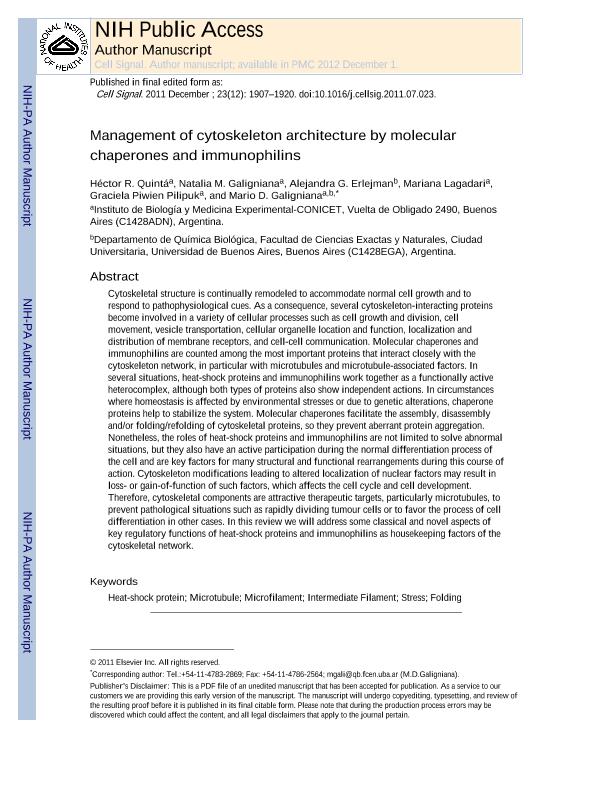Artículo
Management of cytoskeleton architecture by molecular chaperones and immunophilins
Quintá, Héctor Ramiro ; Galigniana, Natalia Maricel
; Galigniana, Natalia Maricel ; Erlejman, Alejandra Giselle
; Erlejman, Alejandra Giselle ; Lagadari, Mariana
; Lagadari, Mariana ; Piwien Pilipuk, Graciela
; Piwien Pilipuk, Graciela ; Galigniana, Mario Daniel
; Galigniana, Mario Daniel
 ; Galigniana, Natalia Maricel
; Galigniana, Natalia Maricel ; Erlejman, Alejandra Giselle
; Erlejman, Alejandra Giselle ; Lagadari, Mariana
; Lagadari, Mariana ; Piwien Pilipuk, Graciela
; Piwien Pilipuk, Graciela ; Galigniana, Mario Daniel
; Galigniana, Mario Daniel
Fecha de publicación:
12/2011
Editorial:
Elsevier Science Inc
Revista:
Cellular Signalling
ISSN:
0898-6568
e-ISSN:
1873-3913
Idioma:
Inglés
Tipo de recurso:
Artículo publicado
Clasificación temática:
Resumen
Cytoskeletal structure is continually remodeled to accommodate normal cell growth and to respond to pathophysiological cues. As a consequence, several cytoskeleton-interacting proteins become involved in a variety of cellular processes such as cell growth and division, cell movement, vesicle transportation, cellular organelle location and function, localization and distribution of membrane receptors, and cell-cell communication. Molecular chaperones and immunophilins are counted among the most important proteins that interact closely with the cytoskeleton network, in particular with microtubules and microtubule-associated factors. In several situations, heat-shock proteins and immunophilins work together as a functionally active heterocomplex, although both types of proteins also show independent actions. In circumstances where homeostasis is affected by environmental stresses or due to genetic alterations, chaperone proteins help to stabilize the system. Molecular chaperones facilitate the assembly, disassembly and/or folding/refolding of cytoskeletal proteins, so they prevent aberrant protein aggregation. Nonetheless, the roles of heat-shock proteins and immunophilins are not only limited to solve abnormal situations, but they also have an active participation during the normal differentiation process of the cell and are key factors for many structural and functional rearrangements during this course of action. Cytoskeleton modifications leading to altered localization of nuclear factors may result in loss- or gain-of-function of such factors, which affects the cell cycle and cell development. Therefore, cytoskeletal components are attractive therapeutic targets, particularly microtubules, to prevent pathological situations such as rapidly dividing tumor cells or to favor the process of cell differentiation in other cases. In this review we will address some classical and novel aspects of key regulatory functions of heat-shock proteins and immunophilins as housekeeping factors of the cytoskeletal network.
Palabras clave:
Chaperones
,
Cytoskeleton
,
Immunophilins
,
Hsp90
Archivos asociados
Licencia
Identificadores
Colecciones
Articulos(IBYME)
Articulos de INST.DE BIOLOGIA Y MEDICINA EXPERIMENTAL (I)
Articulos de INST.DE BIOLOGIA Y MEDICINA EXPERIMENTAL (I)
Articulos(SEDE CENTRAL)
Articulos de SEDE CENTRAL
Articulos de SEDE CENTRAL
Citación
Quintá, Héctor Ramiro; Galigniana, Natalia Maricel; Erlejman, Alejandra Giselle; Lagadari, Mariana; Piwien Pilipuk, Graciela; et al.; Management of cytoskeleton architecture by molecular chaperones and immunophilins; Elsevier Science Inc; Cellular Signalling; 23; 12; 12-2011; 1907-1920
Compartir
Altmétricas



